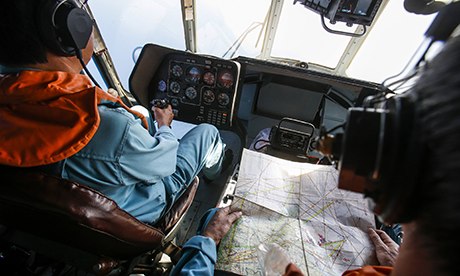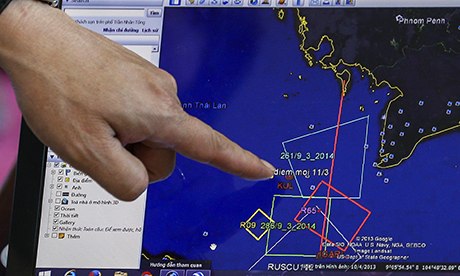
Theories about what happened remain speculative, but the widening search areas suggest that the authorities are genuinely in the dark about the fate of the plane.
How does a plane simply 'disappear off the radar'?
Over land, air traffic controllers can use two types of radar, primary, which detects objects by bouncing back a radio signal, and secondary , where the plane sends back an automatic response, identifying itself. Air traffic consultant Doug Maclean, of DKM Aviation, says: "Secondary surveillance radar sends out a coded question, the interrogation message will be received and sent back; that requires a degree of co-operation between plane and the ground. In the likes of the 9/11 incident, the aircraft would have received messages but hijackers had switched off the reply."
But over longer distances where radar coverage is limited - ie usually when planes are flying across oceans - they use another system, Automatic Dependent Surveillance. Here the aircraft transmits its own signal and gives its position via satellites. Maclean says: "Once you go outside primary radar coverage, which would normally be about 100 miles offshore maximum, you are relying on the plane to be transponding."
Malaysia Airlines has confirmed its plane had a system called ACARS, or the Aircraft Communications Addressing and Reporting System, which would also automatically alert engineers at base of any mechanical failure.
So when flight MH370 disappeared from plane tracking websites, it could mean the signals from the plane's transponder were stopped deliberately (by pilots or others), or there was a complete electrical failure, or the plane disintegrated. Where the Malaysian plane was flying, the signals are picked up by sites only once a minute and only at a plane's cruising height above 29,000 feet. So a dramatic loss of altitude could conceivably also see a plane drop off their radar but potentially continue to travel for some distance.
Why are the searches taking place over such vastly different areas?
Searches have been taking place at sea along the original flight path to Vietnam, and on the other side of the Malay Peninsula in the Strait of Mallaca, and are now being widened even further. At cruising altitude the plane would have been travelling at between 500-600mph - allowing for some considerable distance to be travelled if the plane was still intact when it disappeared from the radar. Even with complete engine failure, some aviation experts have estimated the plane could glide for 20 minutes. Malaysian authorities said on Sunday that the plane could have turned just before vanishing. According to tracking site FlightRadar24, the last data it received showed the plane was changing its bearing, but in a way that matched the usual flight path on that route - although the site's experts say the plane could conceivably have changed path after dropping down. (See a fuller explanation here).
What about the plane?
Any crash eventually ascribed to a fault with a plane is by definition likely to throw up a previously unknown and unenvisaged problem. Boeing has sent a team to Asia to offer assistance as technical advisors. But aviation experts agree that the Boeing 777 has a very good safety record and regard technical failure as much more unlikely than deliberate sabotage or pilot error.
Since June 1995, 777s have made a total of almost five million flights. Malaysia Airlines has 15 Boeing 777-200ER jets in its fleet; more than a thousand fly worldwide, 422 of them of the exact 777-200ER model.
Incidents have occurred: in January 2008 a British Airways 777-200 landed 200 metres short of the runway coming into London Heathrow, with no casualties. Accident investigators discovered that both of the Rolls-Royce engines cut out after ice crystals blocked the fuel pipe. And in November 2008, a similar problem on an internal American flight led to US safety authorities urgently recommending the replacement of a component in all Rolls-Royce Trent 800 series engines on 777s worldwide.
In July 2013, an Asiana Airlines flight to San Francisco crash-landed short of the runway, leading to three deaths. The cause of the first fatal incident on a 777 is still being investigated, but no mechanical problem has been indicated.





Goosebumps were felt when i read this.
"A businessman in Ketereh claimed that he saw a bright white light, believed to be of an aircraft, descending at high speed towards the South China Sea about 1.45am on the day flight MH370 went missing...
Alif said he was in the compound of his home when he saw the bright white light, which he described as similar to the ones used by airplanes during night flights...
It was moving towards the sea, towards Bachok area, which was unusual...
Usually, aircrafts that fly over here have their usual route pattern, but this one went completely towards the other way, he said...
Alif said he watched the light's movement for about five minutes, before realising that it was descending...
He said there was no blinking red light."
[Link]